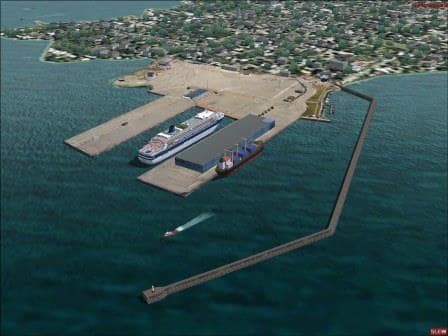I had some connectivity issues, so there are three posts in a row
As expected the white clouds did decend on us as soon as the ship came closer to the Strait of Juan de Fuca. Here the combination of warm – sun heated – land and the cold water of the Northern Pacific being pushed into the Strait created an ideal temperature balance, or disbalance, depending on your point of view, to change the view around the ship into a small white world. Around sunrise the whistle started to blare and keep doing so until near mid day the sun finally burned the fog away.
As the Strait is a very busy area, serving the Whole Vancouver Area, but also the ports around the Puget Sound such as Seattle and Tacoma, there is constant stream of ships going both ways. To make sure that they are all behaving themselves, The Traffic Management Stations were established. Further on the Strait has been divided in an outbound lane and an inbound lane. Outbound is on the Canadian Side and Inbound on the American side. Since the 1970’s these systems have been introduced in all traffic hotspots and bottle necks in the world.
In the Strait they serve three important purposes; A. creating some order in the way ships enter and exit the Strait near the Pacific. B. In the Strait set clear boundaries to keep fishermen away from the large ships, which sometimes can hardly see them C: create a system that makes it possible for Ships to safely split to various routes once approaching the Puget Sound. The latter resulted in several Round – and- about systems where ships are forced to follow a counter clockwise course and thus always safely pass behind another ship, instead of trying to cut across and run into a dangerous situation.
Ships like to sail in straight lines to save time and fuel and not every mariner is a “prudent” mariner as the law requires and hence the implementation of the VSS system, or Vessel Separation System. This system forces ships to sail safe courses and you are only allowed to be a little bit creative in following the standard tracks, if there is absolutely no other traffic around.
This meant that the Amsterdam first sailed to the end of the Strait of Juan de Fuca and then made a 90 turn to the north. By that time the low clouds had been burned away and the guests had a beautiful sunny approach to Victoria. This was by 16.30 in the afternoon and apart from seeing other cruise ships approaching (who also have to comply with the Jones Act before going to Seattle) wildlife gave quite a show as well. A 100 feet from the ship a Humpback whale found the time to loudly applaud our presence with half jumps out of the water and beating the surface with its flipper.
There was a stiff breeze blowing to the North, and that meant that the ship had to go nearly broadside onto it to create a good lee for the pilot boat. With a strong ebbing tide running against the wind, the water looked a places as if a washing machine had gone wild, with white crested eddies. Of course with the wind pushing against the Hull and the funnel and grabbing onto the balconies, it causes the ship to list, so if you do not know what is going one, it all looks very peculiar. The ships is turning away from the port and starts to heel. But safetly first for the pilot and nice sailing second.

The ms Amsterdam docked where in this artist impression we can see the cargo ship. Victoria – Ogden Point.
The harbor of Victoria is located NE to SW and laying in a sheltered curve. So a true southerly wind it not much of a problem for a safe docking. Victoria is issue if a wind is blowing from the SE, as that brings it perpendicular onto the ship. Today while there was a strong wind outside, it was fairly calm near the dock.
I did not go ashore for the evening call although there is a very nice 2nd hand book shop in the main area of the town, but it has the tendency to close at 6 pm. So I spent my time trying to figure out which Elevators on this ship are running on Emergency power. There is always one in each elevator bank, but which one varies from ship to ship.
Departure is set for midnight, with a 6 am arrival in Seattle. That means a quick dash through the Pudget Sound and with the sunny weather that we had all afternoon, I would not be amazed if the clouds come down again. So I will make it an early night and catch some sleep in case the whistle starts again.

July 16, 2014 at 10:15 am
Which elevator is running on emergency power, and on which ship: are they not all ? And, if not: how do folks know towards which elevator to head if on crutches etc. ?
July 17, 2014 at 12:44 am
Good morning,
if you would be on a holland america line ship, there is one in each staircase. and they are labled with a green sign EMERGENCY ELEVATOR
normally near floor level, so all can see and know it.
thank you for reading my blog
Captain Albert
July 16, 2014 at 4:54 pm
Captain, somehow it seems as a deja vu, connection problems….. Internet aboard is an increasing problem. More and more people want a connection, but the sattelite connection can t keep up with them. Nice to experience a number of different ships in a short period on your blogs.